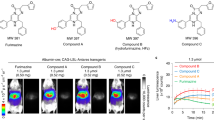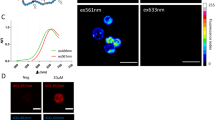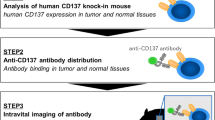Abstract
We developed a new approach to bioluminescent T cell imaging using a membrane-anchored form of the Gaussia luciferase (GLuc) enzyme, termed extGLuc, which we could stably express in both mouse and human primary T cells. In vitro, extGLuc+ cells emitted significantly higher bioluminescent signal when compared to cells expressing GLuc, Renilla luciferase (RLuc) or membrane-anchored RLuc (extRLuc). In vivo, mouse extGLuc+ T cells showed higher bioluminescent signal when compared to GLuc+ and RLuc+ T cells. Application of this imaging approach to human T cells genetically modified to express tumor-specific chimeric antigen receptors (CARs) enabled us to show in vivo CAR-mediated T cell accumulation in tumor, T cell persistence over time and concomitant imaging of T cells and tumor cells modified to express firefly luciferase. This sensitive imaging technology has application to many in vivo cell-based studies in a wide array of mouse models.
This is a preview of subscription content, access via your institution
Access options
Subscribe to this journal
Receive 12 print issues and online access
$209.00 per year
only $17.42 per issue
Buy this article
- Purchase on Springer Link
- Instant access to full article PDF
Prices may be subject to local taxes which are calculated during checkout





Similar content being viewed by others
References
Greer, L.F. III. & Szalay, A.A. Imaging of light emission from the expression of luciferases in living cells and organisms: a review. Luminescence 17, 43–74 (2002).
Scheffold, C., Kornacker, M., Scheffold, Y.C., Contag, C.H. & Negrin, R.S. Visualization of effective tumor targeting by CD8+ natural killer T cells redirected with bispecific antibody F(ab′)(2)HER2xCD3. Cancer Res. 62, 5785–5791 (2002).
Edinger, M. et al. Revealing lymphoma growth and the efficacy of immune cell therapies using in vivo bioluminescence imaging. Blood 101, 640–648 (2003).
Thorne, S.H., Negrin, R.S. & Contag, C.H. Synergistic antitumor effects of immune cell-viral biotherapy. Science 311, 1780–1784 (2006).
Cao, Y.A. et al. Shifting foci of hematopoiesis during reconstitution from single stem cells. Proc. Natl. Acad. Sci. USA 101, 221–226 (2004).
Cao, Y.A. et al. Molecular imaging using labeled donor tissues reveals patterns of engraftment, rejection, and survival in transplantation. Transplantation 80, 134–139 (2005).
Beilhack, A. et al. In vivo analyses of early events in acute graft-versus-host disease reveal sequential infiltration of T cell subsets. Blood 106, 1113–1122 (2005).
Zeiser, R.S. et al. Inhibition of CD4+CD25+ regulatory T cell function by calcineurin dependent interleukin-2 production. Blood 108, 390–399 (2006).
Nakajima, A. et al. Antigen-specific T cell–mediated gene therapy in collagen-induced arthritis. J. Clin. Invest. 107, 1293–1301 (2001).
Tarner, I.H. et al. Retroviral gene therapy of collagen-induced arthritis by local delivery of IL-4. Clin. Immunol. 105, 304–314 (2002).
Serrano, L.M. et al. Differentiation of naive cord-blood T cells into CD19-specific cytolytic effectors for posttransplantation adoptive immunotherapy. Blood 107, 2643–2652 (2006).
Huang, X. et al. Stable gene transfer and expression in human primary T cells by the Sleeping Beauty transposon system. Blood 107, 483–491 (2006).
Kim, Y.J., Dubey, P., Ray, P., Gambhir, S.S. & Witte, O.N. Multimodality imaging of lymphocytic migration using lentiviral-based transduction of a tri-fusion reporter gene. Mol. Imaging Biol. 6, 331–340 (2004).
Tannous, B.A., Kim, D.E., Fernandez, J.L., Weissleder, R. & Breakefield, X.O. Codon-optimized Gaussia luciferase cDNA for mammalian gene expression in culture and in vivo. Mol. Ther. 11, 435–443 (2005).
Riviere, I., Brose, K. & Mulligan, R.C. Effects of retroviral vector design on expression of human adenosine deaminase in murine bone marrow transplant recipients engrafted with genetically modified cells. Proc. Natl. Acad. Sci. USA 92, 6733–6737 (1995).
Brentjens, R.J. et al. Eradication of systemic B cell tumors by genetically targeted human T lymphocytes co-stimulated by CD80 and interleukin-15. Nat. Med. 9, 279–286 (2003).
Brentjens, R.J. et al. Genetically targeted T cells eradicate systemic acute lymphoblastic leukemia xenografts. Clin. Cancer Res. 13, 5426–5435 (2007).
Gong, M.C. et al. Cancer patient T cells genetically targeted to prostate-specific membrane antigen specifically lyse prostate cancer cells and release cytokines in response to prostate-specific membrane antigen. Neoplasia 1, 123–127 (1999).
Costa, G.L. et al. Adoptive immunotherapy of experimental autoimmune encephalomyelitis via T cell delivery of the IL-12 p40 subunit. J. Immunol. 167, 2379–2387 (2001).
Gattinoni, L. et al. Acquisition of full effector function in vitro paradoxically impairs the in vivo antitumor efficacy of adoptively transferred CD8+ T cells. J. Clin. Invest. 115, 1616–1626 (2005).
Hinrichs, C.S., Gattinoni, L. & Restifo, N.P. Programming CD8+ T cells for effective immunotherapy. Curr. Opin. Immunol. 18, 363–370 (2006).
Klebanoff, C.A. et al. Central memory self/tumor-reactive CD8+ T cells confer superior antitumor immunity compared with effector memory T cells. Proc. Natl. Acad. Sci. USA 102, 9571–9576 (2005).
Badr, C.E., Hewett, J.W., Breakefield, X.O. & Tannous, B.A. A highly sensitive assay for monitoring the secretory pathway and ER stress. PLoS ONE 2, e571 (2007).
Cheng, G. & Davis, R.E. An improved and secreted luciferase reporter for schistosomes. Mol. Biochem. Parasitol. 155, 167–171 (2007).
Suzuki, T., Usuda, S., Ichinose, H. & Inouye, S. Real-time bioluminescence imaging of a protein secretory pathway in living mammalian cells using Gaussia luciferase. FEBS Lett. 581, 4551–4556 (2007).
Remy, I. & Michnick, S.W. A highly sensitive protein-protein interaction assay based on Gaussia luciferase. Nat. Methods 3, 977–979 (2006).
Venisnik, K.M., Olafsen, T., Gambhir, S.S. & Wu, A.M. Fusion of Gaussia luciferase to an engineered anti-carcinoembryonic antigen (CEA) antibody for in vivo optical imaging. Mol. Imaging Biol. 9, 267–277 (2007).
Pichler, A., Prior, J.L. & Piwnica-Worms, D. Imaging reversal of multidrug resistance in living mice with bioluminescence: MDR1 P-glycoprotein transports coelenterazine. Proc. Natl. Acad. Sci. USA 101, 1702–1707 (2004).
Kalikin, L.M. et al. In vivo visualization of metastatic prostate cancer and quantitation of disease progression in immunocompromised mice. Cancer Biol. Ther. 2, 656–660 (2003).
Koehne, G. et al. Serial in vivo imaging of the targeted migration of human HSV-TK-transduced antigen-specific lymphocytes. Nat. Biotechnol. 21, 405–413 (2003).
Billotey, C. et al. T-cell homing to the pancreas in autoimmune mouse models of diabetes: in vivo MR imaging. Radiology 236, 579–587 (2005).
Hu, D.E., Kettunen, M.I. & Brindle, K.M. Monitoring T lymphocyte trafficking in tumors undergoing immune rejection. Magn. Reson. Med. 54, 1473–1479 (2005).
Kircher, M.F. et al. In vivo high resolution three-dimensional imaging of antigen-specific cytotoxic T lymphocyte trafficking to tumors. Cancer Res. 63, 6838–6846 (2003).
Quintas-Cardama, A. et al. Multifactorial optimization of gammaretroviral gene transfer into human T lymphocytes for clinical application. Hum. Gene Ther. 18, 1253–1260 (2007).
Latouche, J.B. & Sadelain, M. Induction of human cytotoxic T lymphocytes by artificial antigen-presenting cells. Nat. Biotechnol. 18, 405–409 (2000).
Gade, T.P. et al. Targeted elimination of prostate cancer by genetically directed human T lymphocytes. Cancer Res. 65, 9080–9088 (2005).
Acknowledgements
This work was supported by US National Institutes of Health grants CA95152, CA059350, CA08748, CA086438, CA096945, CA094060 and CA083084, The Alliance for Cancer Gene Therapy, the Damon Runyon Clinical Investigator Award (R.J.B.), The Annual Terry Fox Run for Cancer Research organized by the Canada Club of New York, Kate's Team, W.H. Goodwin and A. Goodwin and the Commonwealth Cancer Foundation for Research and the Experimental Therapeutics Center of MSKCC, the Geoffrey Beene Cancer Foundation, the Chronic Lymphocytic Leukemia Foundation, the Ludwig Center for Cancer Immunotherapy and the Bocina Cancer Research Fund.
Author information
Authors and Affiliations
Contributions
E.B.S. contributed to the design of the experiments, supervised and conducted the experiments and generated the manuscript figures; R.Y. contributed to the design of the experiments; J.L. helped conduct experiments for Figure 5 and Supplementary Figures 1 and 2; Y.N. assisted in the conduct experiments from Figures 1, 2, 3; Blesida and Blesserene Punzalan assisted in the conduct of the in vivo experiments; K.L.P. contributed to the conduct and interpretation of histological analyses; S.M.L. contributed to the design of the experiments; M.S. contributed to the design of the experiments and the review of the manuscript and R.J.B. supervised the project, contributed to the design of the experiments and wrote the manuscript.
Corresponding author
Supplementary information
Supplementary Text and Figures
Supplementary Figs. 1 and 2 (PDF 363 kb)
Rights and permissions
About this article
Cite this article
Santos, E., Yeh, R., Lee, J. et al. Sensitive in vivo imaging of T cells using a membrane-bound Gaussia princeps luciferase. Nat Med 15, 338–344 (2009). https://doi.org/10.1038/nm.1930
Received:
Accepted:
Published:
Issue Date:
DOI: https://doi.org/10.1038/nm.1930
This article is cited by
-
Engineering CAR-T cells to activate small-molecule drugs in situ
Nature Chemical Biology (2022)
-
Whole-Body Imaging to Assess Cell-Based Immunotherapy: Preclinical Studies with an Update on Clinical Translation
Molecular Imaging and Biology (2022)
-
Enhanced noninvasive imaging of oncology models using the NIS reporter gene and bioluminescence imaging
Cancer Gene Therapy (2020)
-
Spatial and temporal tracking of cardiac exosomes in mouse using a nano-luciferase-CD63 fusion protein
Communications Biology (2020)
-
Senolytic CAR T cells reverse senescence-associated pathologies
Nature (2020)



